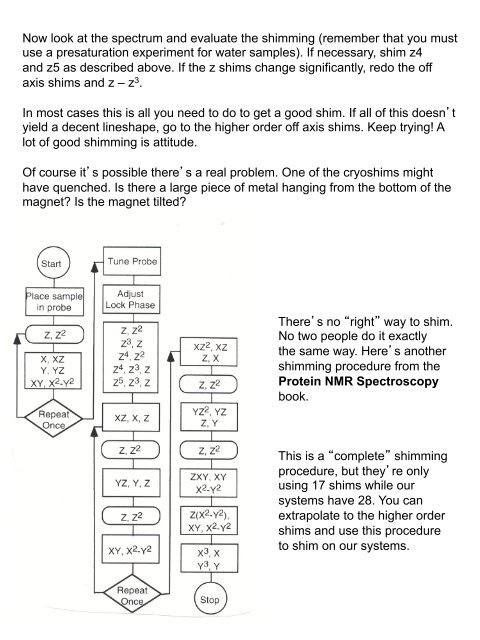Shimming: Theory and Practice - UCLA-DOE
Shimming: Theory and Practice - UCLA-DOE Shimming: Theory and Practice - UCLA-DOE
A Shimming Procedure Before you start shimming there are a few things you should always do. Make sure your sample is at the right depth – centered if its a short sample or in a Shigemi tube, 21mm otherwise (depending on the probe). Start from good shims. Read in a previously saved shim file and make sure its from the same probe you are using. Always lock it with lock D 2 O/H 2 O. This sets the loop gain, loop filter, and loop time and the lock power. After you do this once you can lock and unlock it manually. Unlock the spectrometer and adjust the lock phase. You should also check this sometimes during the shimming process because changes in the shims can change the lock phase. Carefully adjust the lock power so its as high as it can be without saturating. -17 for water and -25 should be close. Shim z, z 2 , and z 3 first, carefully and iteratively. Often you can pull a lot more out of these than you would think. Shim the lower order off axis shims from lowest to highest and back. For Example, shim (x, y) (xz, yz, (x 2 -y 2 ), xy) and (xz 2 , yz 2 , (x 2 -y 2 )z, xyz). Then (xz, yz, (x 2 -y 2 ), xy) and (x, y). Iterate between all the ones in parentheses. In particular remember that if a higher order shim changes (e.g. xz 2 ), you must reshim the lower orders of the degree (xz and x, and also yz and y). Reshim z, z 2 , and z 3 . If there are changes, you might check the low order off axis shims again, then reshim z, z2, and z3. Up until now, all the shimming has been on the lock.
Now look at the spectrum and evaluate the shimming (remember that you must use a presaturation experiment for water samples). If necessary, shim z4 and z5 as described above. If the z shims change significantly, redo the off axis shims and z – z 3 . In most cases this is all you need to do to get a good shim. If all of this doesnt yield a decent lineshape, go to the higher order off axis shims. Keep trying! A lot of good shimming is attitude. Of course its possible theres a real problem. One of the cryoshims might have quenched. Is there a large piece of metal hanging from the bottom of the magnet? Is the magnet tilted? Theres no right way to shim. No two people do it exactly the same way. Heres another shimming procedure from the Protein NMR Spectroscopy book. This is a complete shimming procedure, but theyre only using 17 shims while our systems have 28. You can extrapolate to the higher order shims and use this procedure to shim on our systems.
- Page 1 and 2: Shimming: Theory and Practice Dr. R
- Page 3 and 4: The functions P nm (cosθ) are poly
- Page 5 and 6: Modern shims are coils that produce
- Page 7 and 8: Since the sample is not centered at
- Page 9 and 10: As we misset shims of higher order,
- Page 11 and 12: Shimming the higher order z shims:
- Page 13: Effect of 2,2 (xy or x 2 -y 2 ) inh
- Page 17 and 18: Fourier Imaging Increment # 1 stren
- Page 19 and 20: 1D image of field inhomogeneity a b
- Page 21 and 22: Phase difference -90 -45 0 1 2 3 Im
- Page 23 and 24: 3D images and field mapping G z G x
- Page 25 and 26: Heres a simple example: 1 shim (z),
- Page 27: Spectrum Optimization Topshim perfo
Now look at the spectrum <strong>and</strong> evaluate the shimming (remember that you must<br />
use a presaturation experiment for water samples). If necessary, shim z4<br />
<strong>and</strong> z5 as described above. If the z shims change significantly, redo the off<br />
axis shims <strong>and</strong> z – z 3 .<br />
In most cases this is all you need to do to get a good shim. If all of this doesnt<br />
yield a decent lineshape, go to the higher order off axis shims. Keep trying! A<br />
lot of good shimming is attitude.<br />
Of course its possible theres a real problem. One of the cryoshims might<br />
have quenched. Is there a large piece of metal hanging from the bottom of the<br />
magnet? Is the magnet tilted?<br />
Theres no right way to shim.<br />
No two people do it exactly<br />
the same way. Heres another<br />
shimming procedure from the<br />
Protein NMR Spectroscopy<br />
book.<br />
This is a complete shimming<br />
procedure, but theyre only<br />
using 17 shims while our<br />
systems have 28. You can<br />
extrapolate to the higher order<br />
shims <strong>and</strong> use this procedure<br />
to shim on our systems.



